
Nicoletta Browne, NPS 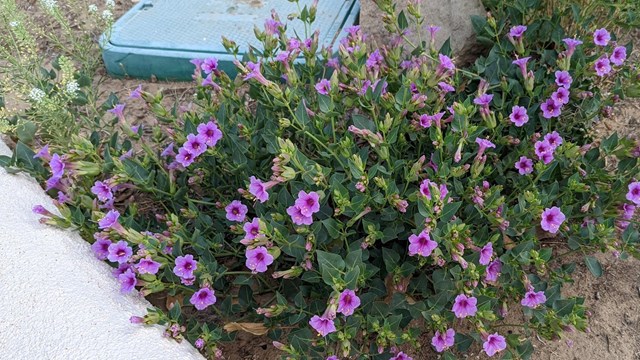
Grasses, Herbaceous Plants, & Succulents
A guide to the grasses, herbs, cacti, and yucca found at Aztec Ruins National Monument. 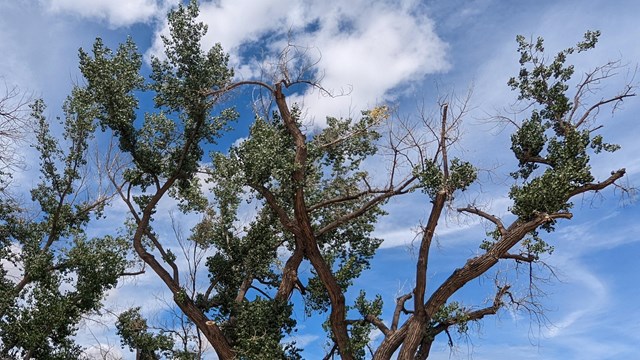
Shrubs and Trees
A guide to the shrubs and trees found at Aztec Ruins National Monument. 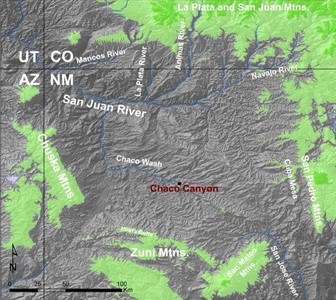
Deanna Grimstead, San Juan Mountain Range Map. Introduction to the Plants of Aztec Ruins and the San Juan BasinThis page provides an introduction to the plants living in the ecological zones ("ecozones") represented within Aztec Ruins National Monument. To go straight to the plant guide, you can follow one of the two links below: The plants found at Aztec Ruins National Monument are a distinct group of organisms that represent the highly biodiverse region of the greater San Juan Basin, which has an area of 21,600 square miles in northwestern New Mexico, southwestern Colorado, and small portions of northeastern Arizona and southeastern Utah. Resting between 5500 and 6500 feet in elevation, this area is defined as being in the semi-desert and shrub-step ecozones, with plant populations of river corridor species, wild grasses, and pinyon and juniper woodlands. The woodland tree species are also represented at the higher elevations of the surrounding mountains: the La Plata and San Juan Mountains to the north, the San Pedro Mountains to the east, the Zuni and San Mateo Mountains to the south, and the Chuska Mountains to the southwest.
The basin itself is an assymetrical structural depression (whose geology you can read about here), through which runs the San Juan River. The river is 355 miles long and originates in the San Juan Mountains of southwestern Colorado, subsequently flowing west through northwestern New Mexico and souheastern Utah before it empties into the Colorado River. Its main tributaries are the Pinos, Piedra, La Plata, Mancos, and Animas Rivers, all of which are in northwestern New Mexico. Aztec Ruins is located next to the Animas River, which also originates from the San Juan Mountains; it passes through Silverton and Durango, Colorado and onto Aztec before it joins the San Juan River in Farmington. Overall, this region has experienced the same climate, with hot and dry summers and cooler winters, for more than a millenium. It is incredibly biologically diverse and has sustained human communities for roughly 10000 to 12000 years. The biodiversity of this region, as well as the southwestern United States as a whole, is best understood through the precolonial uses of wild native plants amongst indigenous peoples, through their traditional harvest and preparation of wild food as well as medicine, fibers, and ceremonial materials. The archeaological record has produced evidence such as charred seeds in ancient hearths, pollen and plant seeds in storage bins, and seeds contained in coprolites (dried human excrement), all of which indicate that, even after agriculture was adapted, wild plants continued to make up a large portion of traditional diets. Different peoples have undertaken varied medicinal and ceremonial uses of plants, with different plant parts being used to treat different ailments. Many have also recognized certain wild plants for their usefulness in making shelters, creating dyes, and constructing baskets, twine, hunting tools, and other useful instruments. One of the primary cultural groups of this area was the ancestral Puebloans, who built the site now known as Aztec Ruins and whose descendents comprise the 21 modern Pueblo nations such as the Hopi, Acoma, Zuni, and Laguna. It is important to recognize that the Puebloans and their modern descendents have shared and continue to share the landscape with neighboring nations, such as the Navajo and Apache (who speak closely-related languages), and the Ute (who share a language ancestor with the Hopi). From the modern Puebloan perspective, their worldview has always been animated by histories of migration, fluidity of movement, and a sense of place and distance that was not limited to specific sites but encompassed entire regions. The ancestral Puebloan worldview of the landscape was also embodied with human meaning and spiritual significance: their subsistence was contingent upon the relationship they held with the earth. The Puebloans depended on their seasonal mobility to search for harvestable plants or wild game, or to rotate and move fields in which they grew domesticated crops. The following entries describe the different ecological zones represented in and around Aztec Ruins National Monument, while briefly listing some of the plants represented there. A more detailed guide for the Native Plant Trail is linked at the top of this page, and one can learn more about crops grown by the ancestral Pueblo people by visiting the page on the Heritage Garden. 
Nicoletta Browne, NPS 
USDA APHIS Archives, www.forestryimages.org, courtesy of Saguaro National Park. Ecological Zones of Aztec RuinsRiparian (River) ZoneOne of the most distinguishing features of the landscape at Aztec Ruins is the Animas River, which flows along the eastern boundary of the monument. The Animas is one of five important tributaries to the San Juan River, flowing from the San Juan Mountains and depositing cobbles and gravel as it flattens out at lower elevations. Cobbles deposited by the river were used both as a construction material and as tools, as outlined on the geology page.The vegetation directly adjacent to this body of water is a community that consists of shrubs and smaller trees such as coyote willow, sagebrush, three-leaf sumac, and rabbitbrush, with a few larger riparian trees such as cottonwood. The plants that thrive in this zone rely on a steady supply of water to survive. Unfortunately, native plants in riparian areas of the San Juan Basin, as well as other riparian areas throughout the southwest, have been threatened by invasive species. At Aztec Ruins, the most prominent invasive species are Tamarisk (salt cedar) and Russian Olive, which choke up large portions of the river corridors and leave little room for native plant communities. Here at the monument, common cultural treatment practices promote the growth of desirable plants and reduce the opportunity for invasive species to become established. Examples of these methods include irrigation and seeding of native plant species, mechanical removal of invasive populations, and precise, timed applications of chemical treatments to select individuals of invasive species, with the intent that the application area be small enough as to not affect native plants. 
NPS Photo Semi-Desert/Shrup Step EcozoneMoving away from the river, the landscape transitions from cobbled and sandy soil into the firm and dense soil of the shrub steppe. Here, there is considerably less water available, but a remarkable amount of plant biodiversity still exists. Here, one can expect to find communities of native grasses and shrubs, including alkali muhly and sacaton grasses, pale wolfberry, four-wing saltbush, rabbitbrush, snakeweed, globemallow, and several species of yucca, sagebrush, and cacti. All of the plants that grow in this ecozone are tolerant of drought and grazing, and are incredibly opportunistic in an area that receives an average of a paltry 9.9 inches of precipitation per year.A challenge that this region and many others in the Southwest currently face is the legacy of past land management practices that resulted in overgrazing and subsequent habitat degradation. Grazing began in the San Juan basin during the 1800s with the introduction of European livestock like domestic sheep and cattle, and overgrazing sometimes resulted in bare land with compacted soil that could not support much plant life. At Aztec Ruins, it is common to find areas that have been affected by overgrazing, such as the North Mesa and the area around Aztec East. There are also visibly bare fields within the park boundaries, with compacted soils and limited native vegetation, that have gone fallow due to heavy agricultural use and over-plowing. To address the issue of the lack of native plant biodiversity in the park, one restoration approach has been to reintroduce native plant communities through hand-seeding, establishing them in micro-habitats such as native plant islands. Woodland EcozoneAlthough sparse at this altitude, woodland communities are indeed found at Aztec Ruins National Monument, interspersed with the other two zones mentioned above. In addition to providing scenery and breaking up the mononoty of the shrub-dominated semi-desert, woodlands provide shade and erosion protection, particularly along riparian areas. Deciduous trees (those that shed leaves seasonally) include cottonwood and coyote willow, as well as invasive species such as tamarisk, russian olive, and siberian elm. Evergreen species, those that retain their leaves year-round, include pinyon pine and juniper, both of which were extensively used by ancestral Pueblo peoples living here.
NPS Photo 
NPS Graphic 
Nicoletta Browne, NPS 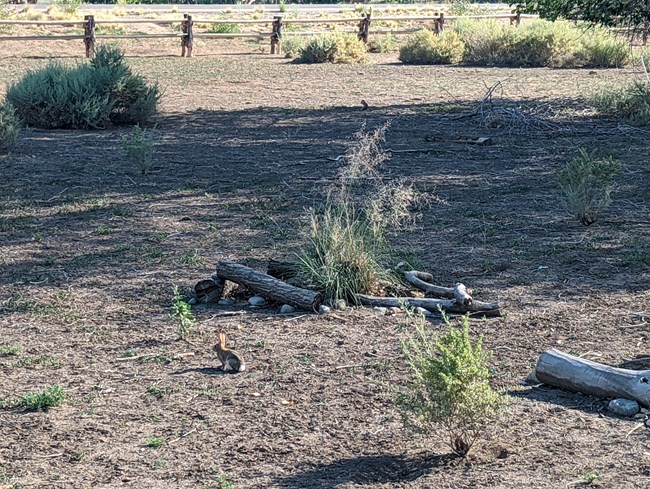
Nicoletta Browne, NPS Habitat Restoration at Aztec Ruins National MonumentAlthough many native plants still survive in the area around Aztec Ruins, the plant communities have been significantly fragmented and degraded. Tamarisk, Russian Olive, and other invasive species choke the waterways, while introduced grasses and weeds have outcompeted native bunchgrasses and herbs in many areas. In addition, intensive agricultural practices and over-grazing have left much of the area bare. At Aztec Ruins, a number of projects are underway to reduce the presence of invasive species and restore native plant communities to the area.Natural Resources staff and volunteers periodically work to remove invasive plants from both the archaeological trail and the Old Spanish Trail. In particular, they have succeeded in reducing the amount of Russian Olive along our segment of the Animas River. Methods include physical removal, as well as highly-targeted and controlled applications of herbicides. Continuous monitoring is crucial to the success of these projects, as these plants can quickly become re-established even once removed. In addition, you may notice clumps of plants growing in otherwise largely-bare fields, surrounded by rocks and branches. These "Native Plant Islands" provide small-scale, manageable plantings of native plants such as prickly pear cactus, bunchgrasses, yucca, and sagebrush in areas that were cleared and heavily plowed for agriculture. The goal is for these communities to establish themselves and create habitat, increasing soil fertility, attracting wildlife, and improving the overall ecological health of the area. 
Photo by Bettymaya Foot, 2017 The Ancestral Pueblo LandscapeIn her article, "Reading the Ancestral Puebloan Landscape," Paleo-Ethnobotanist Carol B. Brandt poses further thoughts about the ancestral Puebloan landscape by reflecting that as modern individuals and societies, the ancestral Puebloan landscape deserves more of our attention in looking at how we identify within our human cultures and how we relate to the Earth. Brandt continues this line of thinking about the Puebloan landscape by saying:I suspect that the landscape for Ancestral Puebloans embodied more than soil and rock, arroyos and mesas. Reading the landscape might have included the querulous call of the pinyon jay in the fall that signaled times to pack baskets for the harvest. A literacy of landscape suggests reading even the delicate tracks of deer mice in the sand to know where rice grass grew in abundance and when the seeds were perfect for roasting. And perhaps by deciphering the patterns of insects caught on the sticky, glandular leaves, they knew which tobacco was pungent and would carry their prayers to the ancestors. Imagine if we could shift our own line of thinking and how we live based on this observation about reading the landscape, how different our world would be. Here at Aztec Ruins National Monument, we encourage you to explore these intersections of culture and the environment further. 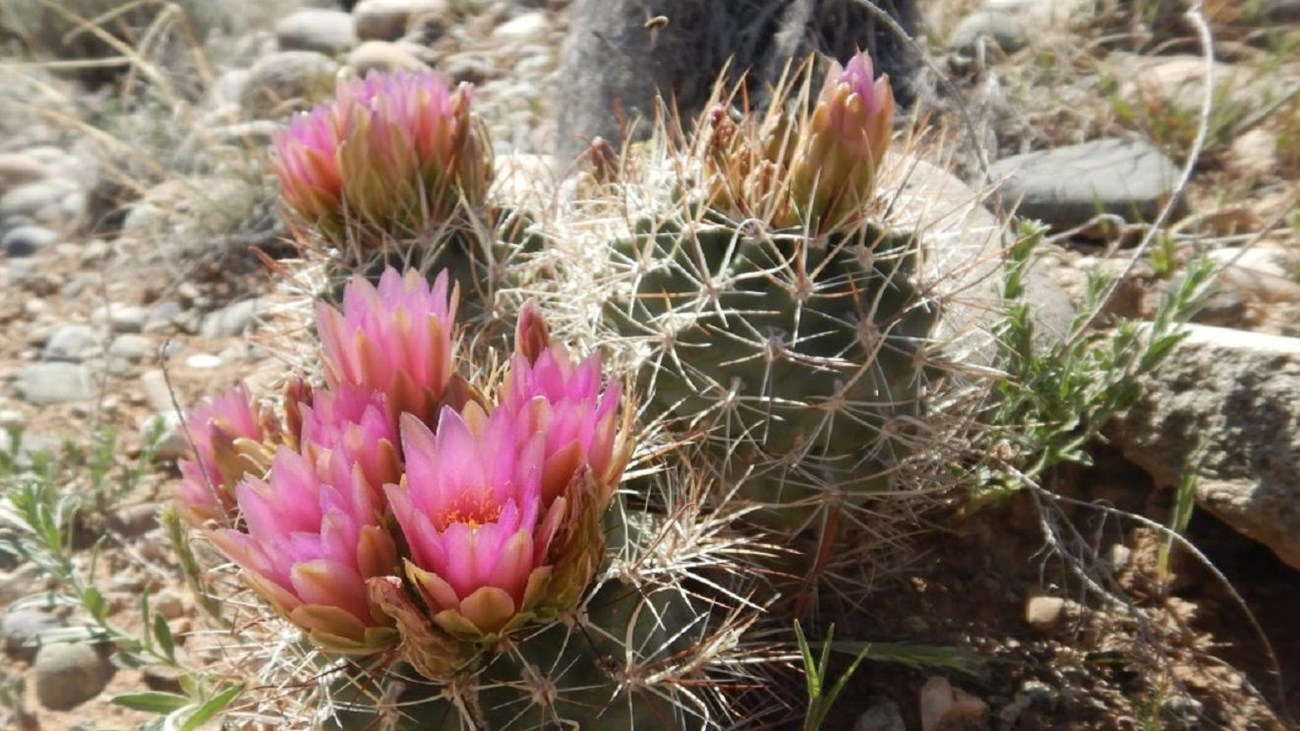
Clover's Fishhook Cactus
Learn more about this rare and beautiful New Mexico endangered plant. |
Last updated: September 19, 2022


